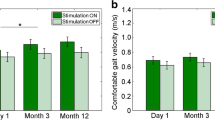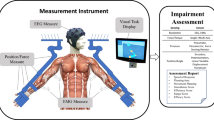Abstract
The foreseen outcome of a rehabilitation treatment is a stable improvement on the functional outcomes, which can be longitudinally assessed through multiple measures to help clinicians in functional evaluation. In this study, we propose an automatic comprehensive method of combining multiple measures in order to assess a functional improvement. As test-bed, a functional electrical stimulation based treatment for foot drop correction performed with chronic post-stroke participants is presented. Patients were assessed on five relevant outcome measures before, after intervention, and at a follow-up time-point. A novel algorithm based on variables minimum detectable change is proposed and implemented in a custom-made software, combining the outcome measures to obtain a unique parameter: capacity score. The difference between capacity scores at different timing is thresholded to obtain improvement evaluation. Ten clinicians evaluated patients on the Improvement Clinical Global Impression scale. Eleven patients underwent the treatment, and five resulted to achieve a stable functional improvement, as assessed by the proposed algorithm. A statistically significant agreement between intra-clinicians and algorithm-clinicians evaluations was demonstrated. The proposed method evaluates functional improvement on a single-subject yes/no base by merging different measures (e.g., kinematic, muscular) and it is validated against clinical evaluation.





Similar content being viewed by others
Abbreviations
- EMG:
-
Electromyography
- EV:
-
Endurance velocity
- CGI-I:
-
Clinical Global Impression scale for Improvement
- CS:
-
Capacity score
- GV:
-
Gait velocity
- ICC:
-
Interclass correlation coefficient
- IS:
-
Improvement score
- MAS:
-
Modified Ashworth Scale
- MDC:
-
Minimum detectable change
- MRC index:
-
Medical Research Council index
- FD:
-
Foot drop
- FES:
-
Functional electrical stimulation
- PSL:
-
Paretic step length
- SEM:
-
Standard error of measurement
- TAAI:
-
Tibialis anterior activation
References
Ambrosini, E., S. Ferrante, A. Pedrocchi, G. Ferrigno, and F. Molteni. Cycling induced by electrical stimulation improves motor recovery in postacute hemiparetic patients: a randomized controlled trial. Stroke 42:1068–1073, 2011.
Ashworth, B. Preliminary trial of carisoprodol in multiple sclerosis. Practitioner 192:540–542, 1964.
Bergquist, A. J., J. M. Clair, O. Lagerquist, C. S. Mang, Y. Okuma, and D. F. Collins. Neuromuscular electrical stimulation: implications of the electrically evoked sensory volley. Eur. J. Appl. Physiol. 111:2409–2426, 2011.
Bohannon, R. W., A. W. Andrews, and M. W. Thomas. Walking speed: reference values and correlates for older adults. J. Orthop. Sports Phys. Ther. 24:86–90, 1996.
Burridge, J. H., and D. L. McLellan. Relation between abnormal patterns of muscle activation and response to common peroneal nerve stimulation in hemiplegia. J. Neurol. Neurosurg. Psychiatry 69:353–361, 2000.
Burridge, J. H., P. N. Taylor, S. A. Hagan, D. E. Wood, and I. D. Swain. The effects of common peroneal stimulation on the effort and speed of walking: a randomized controlled trial with chronic hemiplegic patients. Clin. Rehabil. 11:201–210, 1997.
Burridge, J. H., D. E. Wood, P. N. Taylor, and D. McLellan. Indices to describe different muscle activation patterns, identified during treadmill walking, in people with spastic drop-foot. Med. Eng. Phys. 23:427–434, 2001.
Busner, J., and S. D. Targum. The clinical global impression scale: applying a research tool in clinical practice. Psychiatry 4:28–37, 2007.
Cohen, J. A coefficient of agreement for nominal scales. Educ. Psychol. Meas. 20:37–46, 1960.
Cretuala, A., K. Berveta, and L. Ballaza. Gillette gait index in adults. Gait Posture 32:307–310, 2010.
Davis, R. B., S. Ounpuu, D. Tyburski, and G. R. Gage. A gait analysis data-collection and reduction technique. Hum. Mov. Sci. 10:575–587, 1991.
Eng, J. J., A. S. Dawson, and K. Chu. Submaximal exercise in individuals with stroke: test-retest reliability and concurrent validity with VO2max. Arch. Phys. Med. Rehabil. 85:113–118, 2004.
Flansbjer, U., A. M. Holmback, D. Downham, C. Patten, and J. Lexell. Rehabilitation og gait performance tests in men and women with hemiparesis after stroke. J. Rehabil. Med. 37:75–82, 2005.
Fleiss, J. L. Measuring nominal scale agreement among many raters. Psychol. Bull. 76:378–382, 1971.
Fulk, G., and J. Echternach. Test-retest reliability and minimal detectable change of gait speed in individuals undergoing rehabilitation after stroke. J. Neurol. Phys. Ther. 32:8–13, 2008.
Gandolla, M., S. Ferrante, F. Molteni, G. Guanziroli, T. Frattini, A. Marteganin, G. Ferrigno, K. Friston, A. Pedrocchi, and N. S. Ward. Re-thinking the role of motor cortex: context-sensitive motor outputs? Neuroimage 91:366–374, 2014.
Geyh, S., A. Cieza, J. Schouten, H. Dickson, P. Frommelt, Z. Omar, N. Kostanjsek, H. Ring, and G. Stucki. ICF score sets for stroke. J. Rehabil. Med. 44:135–141, 2004.
Kesar, T. M., S. A. Binder-Macleod, G. E. Hicks, and D. S. Reisman. Minimal detectable change for gait variables collected during treadmill walking in individuals post-stroke. Gait Posture 33:314–317, 2011.
Kottink, A. I., H. J. Hermens, A. V. Nene, M. J. Tenniglo, C. G. Groothuis-Oudshoorn, and M. J. Ijzerman. Therapeutic effect of an implantable peroneal nerve stimulator in subjects with chronic stroke and footdrop: a randomized controlled trial. Phys. Ther. 88:437–448, 2008.
Landis, J. R., and G. G. Koch. The measurement of observer agreement for categorical data. Biometrics 33:159–174, 1977.
Liberson, W. T., H. J. Holmquest, D. Scot, and M. Dow. Functional electrotherapy: stimulation of the peroneal nerve synchronized with the swing phase of the gait of hemiplegic patients. Arch. Phys. Med. Rehabil. 42:101–105, 1961.
Loslever, P., E. M. Laassel, and J. C. Angue. Combined statistical study of joint angles and ground reaction forces using component and multiple correspondence analysis. IEEE Trans. Biomed. Eng. 41:1160–1167, 1994.
Medical Research Council/Guarantors of Brain. Aids to the Examination of the Peripheral Nervous System. London: Baillière Tindall, 1986.
Merletti, R., A. Andina, M. Galante, and I. Furlan. Clinical experience of electronic peroneal stimulators in 50 hemiparetic patients. Scand. J. Rehabil. Med. 11:111–121, 1979.
Rossini, P. M., C. Calautti, F. Pauri, and J. C. Baron. Post-stroke plastic reorganisation in the adult brain. Lancet Neurol. 2:493–502, 2003.
Rostagno, C., and G. F. Gensini. Six minutes walk test: a simple and useful test to evaluate functional capacity in patients with heart failure. Intern. Emerg. Med. 3:205–212, 2008.
Schwartz, M. H., and A. Rozumalski. The Gait Deviation Index: a new comprehensive index of gait pathology. Gait Posture 28:351–357, 2008.
Shutte, L. M., U. Narayanan, J. L. Stout, P. Selber, and J. R. Gage. An index for quantifying deviations from normal gait. Gait Posture 11:25–31, 2000.
Sim, J., and C. C. Wright. The kappa statistic in reliability studies: use, interpretation, and sample size requirements. Phys. Ther. 85:257–268, 2005.
Taylor, P. N., J. H. Burridge, A. L. Dunkerley, D. E. Wood, J. A. Norton, C. Singleton, and I. D. Swain. Clinical use of the Odstock dropped foot stimulator: its effect on the speed and effort of walking. Arch. Phys. Med. Rehabil. 80:1577–1583, 1999.
Von Schroeder, H. P., R. D. Coutts, P. D. Lyden, E. Billings, and V. L. Nickel. Gait parameters following stroke: a practical assessment. J. Rehabil. Res. Dev. 32:25–31, 1995.
Ward, N. S., M. M. Brown, A. J. Thompson, and R. S. Frackowiak. Neural correlates of outcome after stroke: a cross-sectional fMRI study. Brain 126:1430–1448, 2003.
Acknowledgments
This work was made possible thanks to the patients that agreed to participate to the project.
Conflict of interest
The authors report no declaration of interests.
Author information
Authors and Affiliations
Corresponding author
Additional information
Associate Editor Amit Gefen oversaw the review of this article.
Electronic supplementary material
Below is the link to the electronic supplementary material.
Supplemental file 2
Carryover effect evaluation software.exe. This executable file contains a custom-made software developed in Matlab environment (MatlabR2010b) that implements the proposed algorithm and allows carryover effect evaluation. Before to run the application verify the MATLAB Compiler Runtime (MCR) is installed and ensure you have installed version 8.3 (R2014a). If the MCR is not installed, or you have a different version, freely download it from the MathWorks Web site by navigating to—http://www.mathworks.com/products/compiler/mcr/index.html (EXE 552 kb)
Supplemental file 3
Readme.pdf. This pdf file contains the basic information and a short guide for the carryover effect evaluation software use (PDF 323 kb)
Supplemental file 4
Reference values Gandolla et al.xls. This excel file contains the reference value used in the paper for the outcome measures described (XLSX 8 kb)
Supplemental file 5
Template_reference.xls. Template for reference values file preparation (XLSX 8 kb)
Supplemental file 6
Template_patients.xls. Template for patients values file preparation (XLSX 8 kb)
Rights and permissions
About this article
Cite this article
Gandolla, M., Molteni, F., Ward, N.S. et al. Validation of a Quantitative Single-Subject Based Evaluation for Rehabilitation-Induced Improvement Assessment. Ann Biomed Eng 43, 2686–2698 (2015). https://doi.org/10.1007/s10439-015-1317-4
Received:
Accepted:
Published:
Issue Date:
DOI: https://doi.org/10.1007/s10439-015-1317-4




